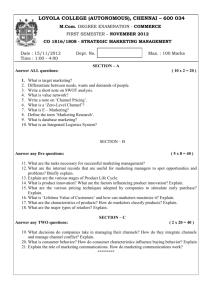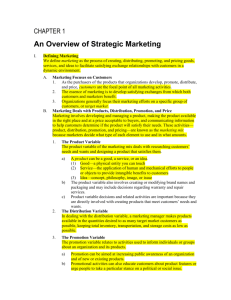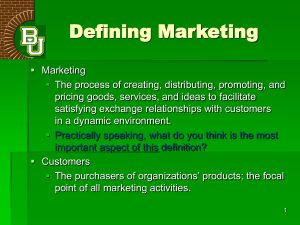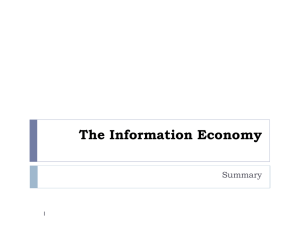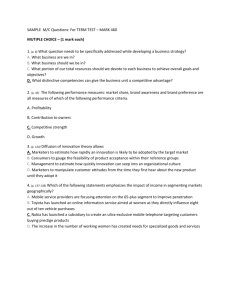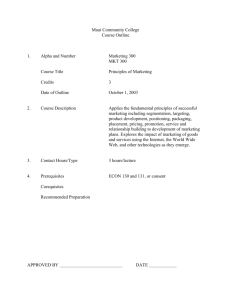Financial Services Marketing
advertisement
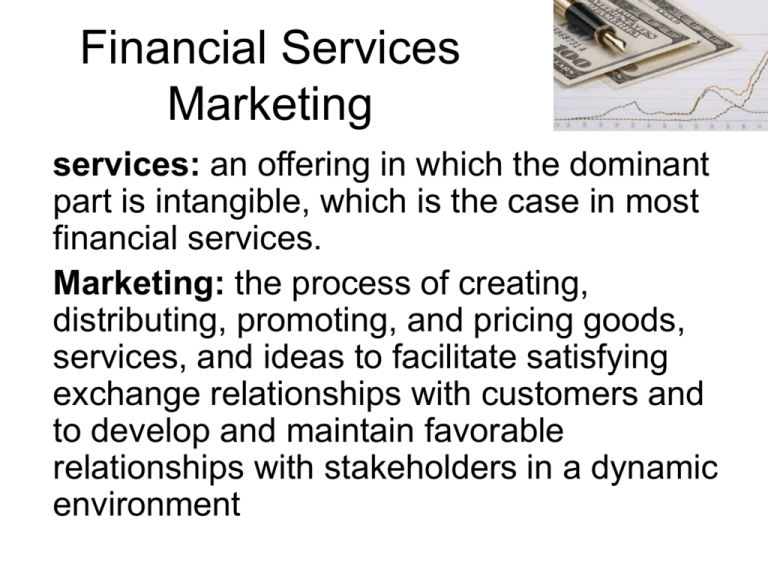
Financial Services Marketing services: an offering in which the dominant part is intangible, which is the case in most financial services. Marketing: the process of creating, distributing, promoting, and pricing goods, services, and ideas to facilitate satisfying exchange relationships with customers and to develop and maintain favorable relationships with stakeholders in a dynamic environment Customers, who are buyers of organization’s products, are the focal point of all marketing activities. The essence of marketing is to develop satisfying exchanges from which both customers and marketers benefit. Organizations generally focus their marketing efforts on a specific group of customers, or target market. Marketing is more than simply advertising or selling a product; it involves developing and managing a product, making the product available in the right place and at a price acceptable to buyers, and communicating information to help customers determine if the product will satisfy their needs. These activities — product, distribution, promotion, and pricing — are known as the marketing mix because marketers decide what type of each element to use and in what amounts. Exchange is “the provision or transfer of goods, services, or ideas in return for something of value”. Customer Relationship Management (CRM) Using information about customers to create marketing strategies that develop and sustain desirable customer relationships. By increasing customer value over time, organizations try to retain and increase long-term profitability through customer loyalty. To manage customer relationships, organizations must develop marketing mixes that create value for customers. Value is “a customer’s subjective assessment of benefits relative to costs in determining the worth of a product” (customer value = customer benefits – customer costs). Customer benefits include anything a buyer receives in an exchange. While, Customer costs include anything a buyer must give up to obtain the benefits provided by the product. Costs include the monetary price of the product as well as non-monetary costs such as time and effort. - The process people use to determine the value of a product is not highly scientific (subjective). - In developing marketing activities, it is important to recognize that customers receive benefits based on their experiences. - The marketing mix can be used to enhance perceptions of value. service-dominant logic view of marketing is that customers are resources and that marketing is achieved with the customer through co-creation of value. Components of Services Marketing: 1- Product Element: the features of the core offering and the bundle of supplementary service elements that surround it. The benefits of the service must be of value to the customer. Components of Services Marketing: 2- Place and time: these elements represent the way in which the service is delivered to the customer. 3- Promotion and education: refers to marketing communications, of which retail financial services make great use of. Education informs how the service can benefit customers and ways in which they can derive additional benefits. Components of Services Marketing: 4- Price and user costs: customers pay for their financial services either directly or indirectly, although pricing is highly competitive. 5- People: the days of the local bank manager have passed, but branch staff, call centre staff and back office staff are vital for the creation of new services, developing systems, selling the services, building and maintaining relationships; investments in training and career development, remuneration and appropriate incentives all form part of a lean but effective workforce. Components of Services Marketing: 6- Process: this refers to means through which the service is created and consumed (or even co-produced). The consumer plays a significant role in the process or creation of the service. 7- Physical evidence: a traditional means of overcoming the intangibility of most services by providing some element of tangible evidence. Components of Services Marketing: 8- Productivity and quality: Productivity refers to the way in which the inputs of the service are translated into outputs that are valued by the customers. In financial services where economies of scale are considered to be critical in driving down costs (not necessarily prices), efficient production has to be central. It is also essential to maintaining quality, without which customers will switch to competitors who offer better quality. However, what constitutes quality and how consumers perceive quality is complex and varied. Switching Cost: The negative costs that a consumer incurs as a result of changing suppliers, brands or products. Although most prevalent switching costs are monetary in nature, there are also psychological, effort- and time-based switching costs. Financial Services Financial Services Institutions: Retail, corporate, investment and private banks • Mutual funds, investment trusts • Personal and group pensions • Life and general insurance and reinsurance companies • Credit card issuers • Specialist lending companies • Stock exchanges • Leasing companies • Government saving institutions • Brokers and agents Financial Services Environment: A number of external forces have exerted influence on the sector, including: 1- Socio-economic factors: play an important rule in determining the demand for financial services. Ex. Changes in the distribution of income and wealth and patterns of consumption. 2- Regulatory environment: Regulations have played a major role in shaping the behavior of suppliers and offering increased protection to consumers. Serve to strengthen the procedures and practices already set in place. Financial Services Environment: 3- Technology: Traditionally paper-based systems have become fully automated, providing greater flexibility and scope for expansion. Without a doubt, technology holds the key to future longterm success for financial institutions, from innovative distribution channels, which are both cost efficient and effective at delivering customer service, to customer databases, which enable better use of target marketing.
